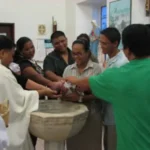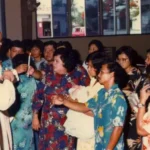Kumpaire/Påri'


Table of Contents
Share This
Relationship term: godfather and child's parents
Kumpaire or påri’ is a religious and social term used to describe the relationship between parents and their child’s godfather. The word kumpaire was borrowed from the Spanish term compadre, adapted, and appropriated into CHamoru/Chamorro cultural tradition. In the Christian rite of baptism, an intricate relationship is formed between the child’s parents and godparents. This initially religious relationship becomes a strong social relationship, enabling the expansion of CHamoru familial social networks, prestige, and resources.
For CHamorus, who are predominantly Catholic due to a history of Spanish colonization that dates back to the 17th century, the religious and social relationship established between a child’s godparents and parents correlates with the social worldview of inafa’maolek (for the common good). The påri’ relationships become part of a larger social system that contributes to the social wellbeing of the entire clan by expanding the family’s social network. Responsibilities of raising a child are shared, spreading the ethic of accountability within the larger clan.
The kumpaire is chosen by the parents whose infant is to be baptized in the Christian faith through the Catholic tradition. Traditionally he would be from the family–a sibling of a parent, cousin, aunt, or uncle–and is selected through careful discernment by one or both parents. Today, a close friend, neighbor, or co-worker would most likely be added to this list of prospective godparents.
Unlike his female counterpart, a kumpaire plays somewhat of a symbolic role in the religious and social formative life of the godchild. This may be due to the matrilineal nature of CHamoru life. He might provide moral support and guidance to his godchild as he or she receives the necessary church sacraments such as Holy Communion, Confirmation, marriage, and in some cases Anointing of the Sick and Ordination. In terms of socialization and enculturation, he would be present in the personal and significant events of the godchild’s life, e.g., birthdays, Christmas, graduation, and other achievements.
Although roles and responsibilities associated with the kumpaire today vary from family to family, at the root of this system is the CHamoru worldview of inafa’maolek which is necessary for the perpetuation of CHamoru culture.
By Antonio Salas, MA
For further reading
Catechism of the Catholic Church. Vatican City: Libreria Editrice Vaticana, 1993.
Chamorro Heritage, A Sense of Place: Guidelines, Procedures and Recommendations For Authenticating Chamorro Heritage. The Hale’-ta Series. Hagåtña: Department of Chamorro Affairs, Research, Publication, and Training Division, 2003.
Hattori, Anne Perez. Colonial Dis-ease: U.S. Navy Health Policies and the Chamorros of Guam, 1898-1941. Pacific Islands Monograph Series 19. Honolulu: University of Hawai’i Press, 2004.
Jorgensen, Marilyn A. Guam’s Patroness: Santa Marian Kamalen. N.p., 1994.
Quan, John F. “The Compradrazgo System of Guam.” PhD diss., Marquette University, 1976.
Rogers, Robert. Destiny’s Landfall: A History of Guam. Honolulu: University of Hawai’i Press, 1995.
